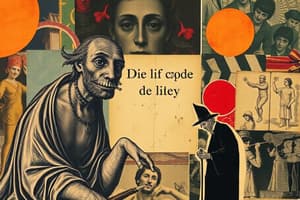Podcast
Questions and Answers
What is the Divine Comedy?
What is the Divine Comedy?
- A long poem written by Dante Alighieri (correct)
- A long Italian poem
- A long poem written by Virgil
- A long poem written by Beatrice
Who are the three guides that accompany Dante in his journey?
Who are the three guides that accompany Dante in his journey?
- Virgil, Beatrice, and Saint Bernard of Clairvaux (correct)
- Virgil, Dante, and Saint Bernard of Clairvaux
- Virgil, Beatrice, and Dante
- Dante, Beatrice, and Saint Bernard of Clairvaux
What are the three beasts that represent three types of sin?
What are the three beasts that represent three types of sin?
- The self-indulgent, the violent, and the malicious (correct)
- The ignorant, the violent, and the malicious
- The self-indulgent, the ignorant, and the malicious
- The self-indulgent, the violent, and the ignorant
What is the first printed edition of the Divine Comedy?
What is the first printed edition of the Divine Comedy?
What is the structure of the Divine Comedy?
What is the structure of the Divine Comedy?
Flashcards are hidden until you start studying
Study Notes
-
The Divine Comedy is a long, Italian poem written by Dante Alighieri.
-
The poem is divided into three parts: Inferno, Purgatorio, and Paradiso.
-
The Inferno is a section of the Divine Comedy that deals with the punishment of sinners in Hell.
-
The Purgatorio is a section of the Divine Comedy that deals with the journey of sinners to Purgatory.
-
The Paradiso is a section of the Divine Comedy that deals with the reward of sinners in Heaven.
-
Dante is accompanied by three guides in his journey through the Divine Comedy: Virgil, Beatrice, and Saint Bernard of Clairvaux.
-
The Divine Comedy is significant for its realism and self-portraiture, which depict human beings as the products of their time, place, and circumstance.
-
Dante was lost in a dark wood and was assailed by beasts he could not evade.
-
He was unable to find the "straight way" to salvation and was rescued by Virgil.
-
Each sin's punishment in Inferno is a contrapasso, a symbolic instance of poetic justice.
-
The three beasts represent three types of sin: the self-indulgent, the violent, and the malicious.
-
Upper Hell, outside the city of Dis, for the four sins of indulgence (lust, gluttony, avarice, anger); Circle 7 for the sins of violence; and Circles 8 and 9 for the sins of fraud and treachery.
-
Added to these are two unlike categories that are specific to Inferno.
-
The Inferno and Purgatorio are two levels of hell, each with its own set of punishments.
-
The Purgatorio is a level of hell for those who were not sinful but were ignorant of Christ.
-
The Mountain of Purgatory is an island in the middle of the world that contains seven terraces representing the seven deadly sins.
-
The Paradiso is a level of heaven that contains the four cardinal virtues and the three theological virtues.
-
The seven lowest spheres of Heaven deal solely with the cardinal virtues.
-
The first three spheres involve a deficiency of one of the cardinal virtues – the Moon, containing the inconstant, whose vows to God waned as the moon and thus lack fortitude; Mercury, containing the ambitious, who were virtuous for glory and thus lacked justice; and Venus, containing the lovers, whose love was directed towards another than God and thus lacked Temperance.
-
The final four spheres are positive examples of the cardinal virtues, all led on by the Sun, containing the prudent.
-
The Divine Comedy is a long poem written by Dante about his journey through Hell, Purgatory, and Paradise.
-
Dante's allegory is complex and can contain many different levels of meaning.
-
The poem is structured with mathematical and numerological patterns, and is often praised for its human qualities.
-
The Divine Comedy was originally written in Italian, but has been translated into many different languages.
-
The first printed edition of the Divine Comedy was published in 1472.
-
The Divine Comedy is often praised for its human qualities, its structure, and its use of real characters.
Studying That Suits You
Use AI to generate personalized quizzes and flashcards to suit your learning preferences.




